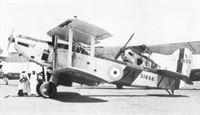Фотографии
-
Регистрационный номер: S1356 A visit to Abu Suier by a batch of aircraft from a Fleet Air Arm carrier. In the foreground is Fairey IIIF Mk III S1356, powered by the trusty Napier Lion (note the windsock on the rudder). The other five aircraft are Blackburn Ripon IIC torpedo bomber/reconnaissance aircraft, also Lion-powered.
Самолёты на фотографии: Blackburn Ripon / T.5 - Великобритания - 1926Fairey Fairey IIIF - Великобритания - 1926
-
Регистрационный номер: S1656 A closer look at one of the visiting Ripon IICs, S1656, powered by a 50 h.p. Lion XIA, was delivered to Sealand between late 1931 and early 1932. A total of 31 Mk IICs were produced, this final Ripon variant having all-metal wings rigged with more sweepback than the composite wood and metal wings of earlier marks. This aircraft was one of 26 later converted to Baffins by installing the Bristol Pegasus II.M3 radial of 580 h.p., and it then went to No 811 Squadron bearing the code 612.
Самолёты на фотографии: Blackburn Ripon / T.5 - Великобритания - 1926
-
Регистрационный номер: K1300 Wapiti K1300 of 'C' Flight, 28 Squadron, with pilot Fg Off Windsor and W/Op LAC Grossey aboard, displays the message pick-up hook extending back from its undercarriage spreader bar. The unit, which was based at Ambala, received Wapitis in September 1931 and flew them until June 1936, when Audaxes took over their general purpose and Army Co-operation duties. A 480 h.p. Bristol Jupiter provided the power.
Самолёты на фотографии: Westland Wapiti - Великобритания - 1927
-
Регистрационный номер: K1181, K1193, K1475 Back to Abu Suier with this formation of pupil-flown Armstrong Whitworth Atlas dual-control advanced trainers of 4 FTS, serialled K1475, K147-, K1181 and K1193. Powered by the 450 h.p. Armstrong Siddeley Jaguar IVC, the Atlas Trainer, of which 175 were supplied to the RAF, soldiered on from 1931 until the appearance of the Hart Trainer in 1935.
Самолёты на фотографии: Armstrong Whitworth Atlas / Ajax - Великобритания - 1925
-
A Gloster Grebe single-seat fighter "coming home to roost" at dusk. The Grebe served as a front-line fighter with the RAF during 1923-1929, and 129 were produced for the Service. This example has the vee strut bracing to the top wing extensions, added to counter wing flutter.
Самолёты на фотографии: Gloster Grebe - Великобритания - 1923
-
Регистрационный номер: J8725, JR8725 An Avro 504N participates in a forced landing competition at Abu Suier (hence the flag markers). The aircraft’s identity is J8725, the ‘R’ being inserted to denote that it has undergone a rebuild. This practice lapsed in the mid-thirties. An Armstrong Siddeley Lynx radial powered this long-serving ab initio trainer.
Самолёты на фотографии: Avro Avro 504N - Великобритания - 1920
-
Регистрационный номер: JR8983 Another rebuilt Lynx-engined Avro 504N, JR8983 sports a blind-flying hood, seen folded down behind the pupil’s cockpit. The characteristic oleo-pneumatic undercarriage and twin underwing fuel tanks are well portrayed.
Самолёты на фотографии: Avro Avro 504N - Великобритания - 1920
Статьи
- -
- A.E.G. GIV /Preservation Profile/ (53)
- News Spotlight
- Personal album
- A.Hitchman - Auster ancestry (1)
- B.Gunston - North American F-86 Sabre part 1 /Fighters of the fifties/ (16)
- B.Johnson - U-Bootsauge
- B.Martin - Britain's civil aircraft register
- J.Bruce - S.E.5: Fighter supreme (5)
- M.Wilson - Space pick-a-back
- R.Riding - A.B.C Robin /British pre-war ultralights/
- R.Riding - Thruxton's Mossies






